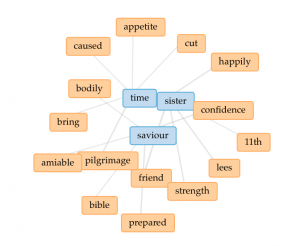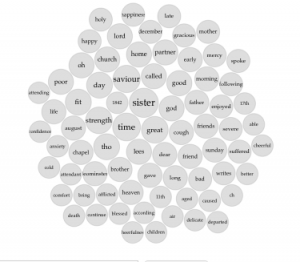As I previously mentioned in Assignment 1, the Memoir of Harriett Lees was about the life of a woman, Harriett Lees. Lees died on January 17th, 1842 at age thirty and was very sick with a bad cough and lung inflammation up until her death. Faith, the Saviour and the Church were extremely important to her because she was brought up learning the principles of the Church of England. She was born on February 11th, 1811 at the Woodford cum Membris in Northampton county. She often cited the Bible and was very moved by spirituality. Lees lost her brother which was extremely devastating to her. She would go to church often to talk with and pray to him and knew that they would soon be reunited. She was often sick and suffered from bad coughs and lung issues. Specifically, in the spring of 1837, she suffered from lung inflammation and was told to go to Lemington to try the water there, and it helped her temporarily. Lees was married on June 4, 1838 to 13th Brother William Lees of Leominster. After she got married, she was admitted to be a member of the Brn’s Church and became a regular at the Church. The following December, Lees had a son, but became sick again not much later. Near her death, she lost her sister which was devastating to her and caused a lot of anxiety. She continued to work for the church as long as she could and often attended services when she was well enough to do so. She gave birth to a second son and seemed to be feeling well after she had him, but that did not last very long. She continued to decline and was worried how this would effect her baby, but she continued to look to her Saviour for help and support. She stuck with her faith, even until the end and helped those in need as much as she could. She passed away leaving behind a husband, siblings, children, and friends.
The research question Paige and I came up with based off our interest in Harriett Lees’ life was: what is the typical language of a married sister in the Moravian Church?
I believe that using Voyant was very helpful in answering our research question. Voyant highlighted the key terms in the memoir of Harriett Lees which gave us insight on what her life was like and what was important to her. I saw how important the Savior was to her based on how frequently the word “Saviour” was used. I also realized how the women in the choir referred to one another as sister because I saw that the word “sister” was used many times and I was able to see the context it was presented in. After visualizing the data with Voyant, I wanted to learn more about the Moravians and came up with new questions. I want to know what a typical life is of a married sister in the Moravian Church and then I want to be able to compare it to the life of an unmarried woman from the same time period and location and see the differences. These questions that emerged through my use of Voyant stem from Johanna Drucker’s definition of visualization in the Whitley readings. She defined visualization as a tool that can provoke or inspire many questions instead of just answering one specific question.
After putting the text into Voyant, I learned that the Harriett Lees Memoir has 2,099 total words and 731 unique word forms. I find this very interesting because a high percentage of words used were not used more than once showing me that Lees was well-versed and most likely well-educated. Each sentence averaged about 80.7 words, which is also very high and affirms the idea of Lees being educated as a high average sentence length symbolizes a high education level. Another piece of data that Voyant provided me with was that the five most frequently used words (excluding stop words) in Lees’ memoir were: sister, time, savior, great, strength. I feel that because Lees used these words so often, they must have been ideas or things that were of much importance to her, which goes along with my idea that she looked toward her Saviour for strength. The word “sister” was very prevalent because that is what she was referred to by others and what women in the Church referred to one another as. Also because the text is a memoir and she went through major events in her life, it makes sense that “time” was a frequently used word.
In order to get the distinctive words and their collocates from the Harriett Lees memoir, I uploaded the Memoir of Br John Willey into Voyant. I found that the distinctive words in the Lees memoir were: tho, fit, partner, oh, and lees. Out of these five words, “partner” is the most important for my research because it answers the question we proposed. A married Moravian women most often used the word “partner” which makes complete sense. It was used in the context of discussing the relationship between Harriett Lees and her husband. They were very supportive of one another and stood by each other in difficult times. Voyant allowed me to partake in distant reading, a concept from the Whitley reading. Instead of closely reading every text, I looked at the patterns that emerged when comparing the two texts. It made seeing connections easier.
The visualizations I made from Voyant allow me to practice spatial reading, another concept from the Whitley reading. Spatial reading is transforming text into forms that takes advantage of visual perception instead of just using typical sequential reading. It uses patterns and creates “concept shapes.”Here are links to the visualizations I created from the memoir as well as screenshots of the visualizations themselves:


https://voyant-tools.org/?corpus=67f7a00f90e4fa7174f62b6c28f39208&view=TextualArc

https://voyant-tools.org/?corpus=67f7a00f90e4fa7174f62b6c28f39208&query=strength&view=TermsBerry
Hailey Zimmerman is a sophomore finance major at Bucknell University in Lewisburg, PA. She is from Darien, CT.
